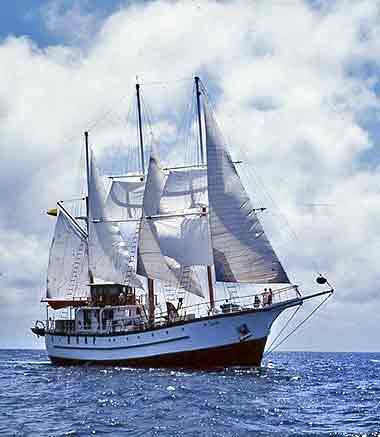| Cloud Ridge Naturalists 2 0 0 7 | ||||
 |
||||
| Blue-Footed Boobie, photo Audrey Benedict | ||||
| Darwin's Islands: The Galapagos & the Ecuadorian Highlands |
||||
|
C O N T E N T S
|
||||
|
HOME PAGE / INTRODUCTION 2007 WILD OCEAN MISTS: A Naturalist's Voyage to Glacier Bay Natl. Park & Lituya Bay WILDERNESS IMAGES: An Artist's Voyage of Discovery to Southeast Alaska's Inside Passage BATHURST INLET: A Journey to the Canadian Arctic CONSERVATION WORKSHOPS THE VIEW FROM BLUE GLACIER: A Natural History of Washington's Olympic Peninsula |
November 27-December 10, 2007 Ship Nights: 24 Dr. Geoff Hammerson, Audrey Benedict, the Crew of the S/S Sagitta, Fernando Polanca and the Staff of Hacienda Zuleta Exploring the island wilderness of the Galapágos by small sailboat is a dream come true for most naturalists. To combine such a voyage with a visit to Ecuador’s magnificent highlands is to experience both ends of the wilderness spectrum—the unique alchemy of wildlife-rich desert islands and the cloud-capped magic of the Andes. The Galapágos, a scattering of volcanic islands located some 600 miles west of mainland Ecuador, have become a symbol of biological diversity because of the unique life-forms that developed there over the millenia. The islands were officially discovered—quite by accident—in 1530, by Fray Tomás de Berlanga, the Bishop of Panamá, when his ship’s course was diverted westward by the strong Humboldt Current. Though Fray Tomás found the remote islands to be dry and inhospitable, his fascination with the giant land tortoises he encountered there gave the islands their name—the Galapágos (Spanish for “tortoises”). The islands provided a refuge for pirates and buccaneers, and were later used by whalers and sealers to provision their ships (taking live tortoises aboard as a food supply!) and to exploit the abundance of marine mammals offshore. The Galapágos most famous visitor, Charles Darwin, explored the Galapágos in 1835, aboard the H.M.S. Beagle. Darwin’s keen observations and collections, most notably focusing on thirteen species of Galapágos finches with varied bill shapes and feeding habits, provided the basis for his pioneering theory of evolution. Our eight-day ocean voyage begins with a charter flight from Quito to the Galapágos, where we’ll board our 16-passenger sailboat. The small size of our group and the classic ambience of the S/S Sagitta allows us a far more intimate look at these magical islands than is possible on a larger ship. Sailing from Baltra Island, we’ll visit North Seymour I., hiking along a loop trail that affords wonderful looks at colonies of Magnificent Frigate birds and Blue-Footed Boobies.
The S/S Sagitta At Santa Cruz I., we’ll visit the Darwin Research Station, explore the highland Scalesia forest and the twin craters known as Los Gemelos, and encounter our first wild, free-ranging Giant Tortoises. On Española I., the southernmost island in the archipelago, we’ll wander the crescent-shaped beach at Gardner Bay, home to several raucous colonies of sea lions, sun-basking Lava Lizards, Sally Lightfoot Crabs, the endemic Hood Mockingbird, and many other species. At Punta Suárez, we’ll see groups of endemic, reddish-hued Marine Iguanas decorate the rocks and look for nesting Masked Boobies, Swallow-tailed Gulls, Galapágos Hawks, and Waved Albatrosses. Landing on the olivine sands at Punta Cormorán, on Floreana I., we’ll snorkel amongst Green Sea Turtles and colorful fish in the submerged crater known as the Devil’s Crown. Sailing on to Isabela I., we’ll hike along the lower flanks of Volcán Acedo and take a panga ride in Elizabeth Bay, which offers good looks at Flightless Cormorants, Marine Iguanas, and Galapágos Penguins. On Fernandina I., the most volcanically-active of the islands, we’ll hike across a stark lava landscape as we make our way to the largest colony of Marine Iguanas in the Galapágos. Marvelous photographic opportunities— fur seals, sea lions, crabs, iguanas, oystercatchers, and herons—await us on Santiago I. before we sail on to Bartolomé I., where we’ll spend the afternoon with Galapágos Penguins. On our final day, at Black Turtle Cove on Santa Cruz I., we’ll enjoy a panga ride through a mangoveedged inlet that is home to Green Sea Turtles, White-tipped Reef Sharks, and the beautiful Spotted Eagle Ray. Our Ecuadorian journey continues as we travel from Quito, past the snowcapped Cayambe volcano (18,991 ft.), to beautiful, historic Hacienda Zuleta. Built in 1691, Hacienda Zuleta has retained a welcoming, Old World ambience. To visit Zuleta is to step back in time—to experience four centuries of Ecuadorian history, embracing Pre- Columbian, Spanish, and Ecuadorian traditions. We’ll spend three days exploring this 4,000-acre working hacienda (touring the dairy, artisanal cheese factory, organic gardens, the women’s embroidery project, and the famous Zuleteño horses). Our hikes will take us to the Caranqui Pyramid (pre-Inca), the Andean Condor rehabilitation center, through sweeping expanses of páramo grasslands, and bird-rich cloudforests. Our stay at Hacienda Zuleta provides an unforgetable introduction to the traditional lifeways of the Andean highlands. Price: $4,750. (includes a $500 deposit) Group Size: 16 Trip Rating: 3 Price includes: Three nights’ lodging in Quito (Hotel Colon), roundtrip charter flight between Quito and the Galapágos, 7 nights/8 days aboard the 16-passenger S/S Sagitta (double upper/single lower berth cabins with private facilities, hot and cold water, air conditioning), all meals, naturalist guide services and instructional materials throughout the tour, Galapágos National Park fees and visitor taxes, all gratuities to crew and hacienda staff, and bus/van transportation for all landbased travel. Does not include alcoholic beverages or items of a personal nature. Land/cruise prices are per person and are based on double occupancy. Single supplements are available for hotel lodging only. |
|||
|
Contact:
|
Cloud Ridge Naturalists 8297 Overland Road Ward Colorado 80481 email > cloudridgeadb@earthlink.net |
|||
